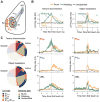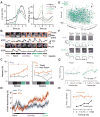Neocortical dynamics during whisker-based sensory discrimination in head-restrained mice
- PMID: 28919043
- PMCID: PMC5726900
- DOI: 10.1016/j.neuroscience.2017.09.003
Neocortical dynamics during whisker-based sensory discrimination in head-restrained mice
Abstract
A fundamental task frequently encountered by brains is to rapidly and reliably discriminate between sensory stimuli of the same modality, be it distinct auditory sounds, odors, visual patterns, or tactile textures. A key mammalian brain structure involved in discrimination behavior is the neocortex. Sensory processing not only involves the respective primary sensory area, which is crucial for perceptual detection, but additionally relies on cortico-cortical communication among several regions including higher-order sensory areas as well as frontal cortical areas. It remains elusive how these regions exchange information to process neural representations of distinct stimuli to bring about a decision and initiate appropriate behavioral responses. Likewise, it is poorly understood how these neural computations are conjured during task learning. In this review, we discuss recent studies investigating cortical dynamics during discrimination behaviors that utilize head-fixed behavioral tasks in combination with in vivo electrophysiology, two-photon calcium imaging, and cell-type-specific targeting. We particularly focus on information flow in distinct cortico-cortical pathways when mice use their whiskers to discriminate between different objects or different locations. Within the primary and secondary somatosensory cortices (S1 and S2, respectively) as well as vibrissae motor cortex (M1), intermingled functional representations of touch, whisking, and licking were found, which partially re-organized during discrimination learning. These findings provide first glimpses of cortico-cortical communication but emphasize that for understanding the complete process of discrimination it will be crucial to elucidate the details of how neural processing is coordinated across brain-wide neuronal networks including the S1-S2-M1 triangle and cortical areas beyond.
Keywords: calcium imaging; discrimination; mouse; neocortex; somatosensory.
Copyright © 2017 The Author(s). Published by Elsevier Ltd.. All rights reserved.
Figures





Similar articles
-
Behaviour-dependent recruitment of long-range projection neurons in somatosensory cortex.Nature. 2013 Jul 18;499(7458):336-40. doi: 10.1038/nature12236. Epub 2013 Jun 23. Nature. 2013. PMID: 23792559
-
Pathway-specific reorganization of projection neurons in somatosensory cortex during learning.Nat Neurosci. 2015 Aug;18(8):1101-8. doi: 10.1038/nn.4046. Epub 2015 Jun 22. Nat Neurosci. 2015. PMID: 26098757
-
Behavioral Consequences of a Bifacial Map in the Mouse Somatosensory Cortex.J Neurosci. 2017 Jul 26;37(30):7209-7218. doi: 10.1523/JNEUROSCI.0598-17.2017. Epub 2017 Jun 29. J Neurosci. 2017. PMID: 28663199 Free PMC article.
-
Anatomical loops and their electrical dynamics in relation to whisking by rat.Somatosens Mot Res. 1999;16(2):69-88. doi: 10.1080/08990229970528. Somatosens Mot Res. 1999. PMID: 10449057 Review.
-
Information processing across behavioral states: Modes of operation and population dynamics in rodent sensory cortex.Neuroscience. 2018 Jan 1;368:214-228. doi: 10.1016/j.neuroscience.2017.09.016. Epub 2017 Sep 20. Neuroscience. 2018. PMID: 28939257 Review.
Cited by
-
Thalamic afferents to prefrontal cortices from ventral motor nuclei in decision-making.Eur J Neurosci. 2019 Mar;49(5):646-657. doi: 10.1111/ejn.14215. Epub 2018 Dec 3. Eur J Neurosci. 2019. PMID: 30346073 Free PMC article. Review.
-
High-frequency burst spiking in layer 5 thick-tufted pyramids of rat primary somatosensory cortex encodes exploratory touch.Commun Biol. 2021 Jun 10;4(1):709. doi: 10.1038/s42003-021-02241-8. Commun Biol. 2021. PMID: 34112934 Free PMC article.
-
Origins of the Resting-State Functional MRI Signal: Potential Limitations of the "Neurocentric" Model.Front Neurosci. 2019 Oct 23;13:1136. doi: 10.3389/fnins.2019.01136. eCollection 2019. Front Neurosci. 2019. PMID: 31708731 Free PMC article. Review.
-
High-Accuracy Detection of Neuronal Ensemble Activity in Two-Photon Functional Microscopy Using Smart Line Scanning.Cell Rep. 2020 Feb 25;30(8):2567-2580.e6. doi: 10.1016/j.celrep.2020.01.105. Cell Rep. 2020. PMID: 32101736 Free PMC article.
-
Amygdala and Cortex Relationships during Learning of a Sensory Discrimination Task.J Neurosci. 2024 Aug 21;44(34):e0125242024. doi: 10.1523/JNEUROSCI.0125-24.2024. J Neurosci. 2024. PMID: 39025676 Free PMC article.
References
-
- Aronoff R, Matyas F, Mateo C, Ciron C, Schneider B, Petersen CC. Long-range connectivity of mouse primary somatosensory barrel cortex. Eur J Neurosci. 2010;31:2221–2233. - PubMed
-
- Bastos AM, Vezoli J, Bosman CA, Schoffelen JM, Oostenveld R, Dowdall JR, De Weerd P, Kennedy H, Fries P. Visual areas exert feedforward and feedback influences through distinct frequency channels. Neuron. 2015;85:390–401. - PubMed
Publication types
MeSH terms
Grants and funding
LinkOut - more resources
Full Text Sources
Other Literature Sources

